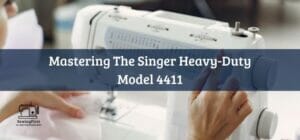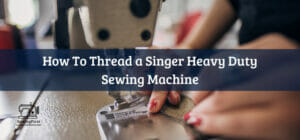Do you have a sewing machine that keeps jamming underneath when you try to sew? Are you feeling frustrated, overwhelmed, and unsure of where to turn for help? It can be incredibly disheartening when something as simple as using your sewing machine turns into an uphill battle. But don’t worry – we’re here to help!
In this article, we’ll explore why these common issues occur with sewing machines and provide some tips on how to prevent them from happening again in the future. We want to make sure that all our readers feel safe while they’re working on their projects, so each tip will provide advice on how best to avoid potential risks or hazards.
We understand that dealing with a malfunctioning machine is not only inconvenient but also potentially dangerous. With this article, we hope to give our readers greater confidence in being able to use their machines safely and effectively. So let’s get started and find out what could be causing your sewing machine jams!
Related Topic: What is the Cause of Skip Stitches in Sewing Machines: Mystery Solved!
Table of Contents
ToggleCauses Of Jamming
Jamming. It’s an incredibly frustrating problem that can ruin a project or a garment and even make it difficult to finish the simplest of tasks. For those who love sewing, jamming can be particularly disheartening – especially when you don’t know why your machine is doing this!
Before we dive into troubleshooting the issue, let’s take a look at some of the common causes of jamming in a sewing machine. The presser foot pressure may not be set correctly for certain fabrics; another potential culprit could be incorrect bobbin tension. Additionally, using too small or large of a needle size compared to the type of thread being used also plays a role in causing jams.
No matter what the cause, though, tackling jamming problems requires attention and patience while adjusting settings until they are just right. With that said, let’s move on to examining how thread tension issues might affect our machines.
Thread Tension Issues
Thread tension issues are a common cause of thread jams and loops. When the tension isn’t set correctly, it can result in the needle either pulling too much or not enough thread through the fabric as you sew. If there is too much tension, this could lead to the thread bunching up underneath your project; conversely, if there’s not enough tension, then loopy stitches might form on top of your work.
To tackle this problem, start by adjusting the upper and lower tensions for each type of fabric until they match. Refer to your sewing machine manual for more detailed information about how to adjust these settings properly – but bear in mind that some fabrics require different amounts of pressure than others.
Additionally, make sure all threads have been pulled taut before beginning stitching; any loose ends could contribute to jamming problems.
If you’ve already tried fiddling with the above measures without success, consider changing out both the needle and bobbin case when troubleshooting further. Different types of needles and cases may be better suited for certain projects, so switching them up could help reduce jamming risks significantly!
Needle And Bobbin Problems
You’d think that a sewing machine needle and bobbin thread would be the dream team for smooth stitching – but unfortunately, this isn’t always the case. Issues with either component can lead to jamming beneath your project, so it pays to take a closer look at both when troubleshooting.
For starters, check whether you’re using the right type of needle for your fabric and project. Needles come in different sizes and styles, some better suited for certain tasks than others. If you’ve been having trouble with tangling or bunching up threads on heavier fabrics, try switching out to an extra-large needle as these are specially designed for thicker materials.
Additionally, make sure that all parts of the needle have been securely tightened before beginning any stitch work; if they become loose during use then jams could occur below.
Not only should you consider changing your sewing machine needle but also pay attention to the bobbin thread too! Threads made from different fibers require varying tensions when winding onto bobbins, meaning incorrect settings could cause problems later down the line.
Take time to rewind each new spool with precision – otherwise, your projects may suffer from issues such as skipped stitches or uneven tension along seams.
With a bit of patience and care though, both needles and bobbins needn’t pose any great difficulty in achieving success with your next masterpiece!
Why Does My Sewing Machine Keep Jamming Underneath Fabric Feeding Difficulties
Sometimes, the fabric itself can be to blame for your jam-ups. If your feed dogs – the teeth that move along and guide the material – aren’t getting a good grip on what you’re working with, then it could lead to bunching up underneath.
Make sure to choose fabrics that are compatible with your machine; some machines prefer cotton or other natural fibers while others can handle more delicate materials like lace and silk. It’s also worth double-checking any stretchy fabrics too as they need extra care when feeding through mechanisms.
Once you know which type of fabric works best for your project, set about adjusting its tension correctly. Too tight and cloth won’t pass easily beneath the needle plate, whereas if it’s too lose it will have trouble staying in place during stitching. Get this balance right and you should find that everything runs much smoother!

Finally, check out whether there is anything obstructing the foot pedal control like threads or scraps of material – these impediments can cause problems such as sudden stopping or jerking motions during operation.
Keep an eye out for anything blocking the path of progress here and remove them before beginning each new stitch job. With all these elements taken into account, you’ll be back on track toward successful sewing sessions!
Wrong Type Of Fabric
Sometimes, the wrong type of fabric can be a major culprit when it comes to sewing machine jams. When using material that’s too heavy or thick for your particular machine, you may find that the upper thread isn’t able to move freely through its guides and tension discs.
This will inevitably lead to snags in the cloth beneath as well as problems with spooling up – potentially resulting in huge headaches down the line!
So, if you want to avoid these issues altogether then make sure to use fabrics that are compatible with your model’s specifications. That way, you won’t have any nasty surprises when you come to start stitching.
Additionally, double-check all of your threads for breaks or knots which could also cause blockages; once again leading to embarrassing pauses during operation.
To keep on top of this problem and ensure smooth sailing throughout each project, take some time every now and then to inspect how everything is running together – regular maintenance really goes a long way toward avoiding those dreaded jam-ups! With little effort put into ensuring things run correctly from day one, you’ll soon be crafting like never before…
Machine Maintenance
It’s also important to ensure that your sewing machine is well-maintained. This means checking for any snagged thread tails, ensuring proper tension on the threads, and making sure nothing has become loose or broken from its place.
If you’re not familiar with how a particular model works then it may be worth getting someone who is experienced in this area to take a look as they can offer advice on what needs fixing – better safe than sorry!
Additionally, always make sure that your bobbin case is clean and free of lint buildup. To do this, gently remove the casing before wiping away any excess dust particles using a soft brush or cloth; once complete, replace it back into its housing securely.
Doing so will help reduce instances of jamming beneath the fabric while simultaneously improving your overall stitching quality too!
Finally, regular oiling should be done at least twice a year depending on usage levels – this keeps all moving parts running smoothly without any obstructions along the way. Pay special attention to areas where metal meets metal such as gears and pulleys; if left unattended these components could easily corrode and cause major problems later down the line.
With a little extra care and attention paid to maintaining your machine correctly, you’ll soon have a reliable companion every time you decide to get creative with some fabrics!
Cleaning The Machine
Now that you have ensured everything is in its place and your machine is well-maintained, it’s time to give it a good clean. Thread bunching can sometimes occur from dust particles or lint accumulation; this will cause the upper thread tension to be off balance resulting in poor stitching quality.
To avoid this, begin by using a bobbin threader to gently remove any tangled threads then wipe away any debris with a soft cloth before cleaning out the casing. This should help reduce instances of thread bunching and other issues when sewing.
Next, inspect all areas for signs of wear and tear such as frayed edges on belts or loose screws – if anything looks suspicious then it may be worth replacing these components altogether as they could break at any moment and leave you stranded without your trusty companion!
Additionally, always ensure that the power switch is turned off while conducting maintenance work – even after unplugging – just to make sure no accidents happen during repairs.
Finally, pay special attention to the feed dogs which are responsible for guiding fabric through the machine when stitching; try giving them a light oiling every couple of weeks depending on usage levels to keep everything running smoothly.
Doing so also helps to prevent more serious issues later down the line like jammed gears or broken needles so take some extra care now and you’ll thank yourself later!
Lubricating The Machine Parts
Now that your machine is clean, it’s time to ensure all parts are well-lubricated. This will help keep everything running smoothly and minimize the chances of thread bunching or jamming underneath. Start by using the correct type of lubricant for each part – not all types are suitable so make sure you use one specified by the manufacturer’s manual.
Once ready, apply a small amount on any moving metal pieces such as gears and pulleys while carefully avoiding contact with electrical components. Extra caution should also be taken when dealing with sharp edges which could easily slice through poor-quality threads!
Next, check the upper thread tension and adjust it if necessary; this can sometimes cause problems if too loose or tight. If unsure how to do this properly then refer back to the user guide for more information before making any changes – better safe than sorry after all!
Additionally, take extra care when handling delicate parts such as bobbin cases as these may require special attention depending on their build material and design complexity.
To finish up, inspect presser feet for signs of damage or wear & tear – replacing them regularly helps maintain an even stitch length throughout projects without struggling against jammed fabric layers!
This way you can be sure your stitching remains consistent from start to finish giving you maximum control over every project you embark upon. Moving forward, let’s look into checking the timing of your sewing machine.
Checking The Timing Of The Machine
Before you can move on to adjusting the pressure foot, it’s important that your machine is in proper working condition. This means checking the timing of your sewing machine and making sure any thread has been threaded correctly. Improper threading or using a too-thick spool of thread can cause issues when tension isn’t balanced properly throughout every stitch.
Start by ensuring upper thread tension is set at an appropriate level – refer back to user instructions if unsure what this should be for best results. Then check whether the bobbin case is properly aligned with the needle plate before winding up some fresh new bobbins with matching colors!
Once done, test out the stitch quality on scraps of fabric to make sure everything looks consistent from one side to another – adjust accordingly until satisfied with the outcome.
Finally, take a look inside the bobbin area and inspect its components closely for signs of damage such as rust or wear & tear which could interfere with smooth operation over time.
If all seems good then proceed onwards towards examining the pressure foot; however, if something doesn’t seem right then don’t hesitate to contact customer service for further assistance! With that being said, let’s move on to taking a closer look at how we can adjust our pressure foot.
Adjusting The Pressure Foot
Time to tackle the tensioning of our sewing machine! It’s like trying to put a square peg in a round hole, but with some guidance, we can get it just right. To begin our journey, let’s first turn our attention to the take-up lever.
This is used to adjust thread tension when you’re stitching and should be set at an appropriate level – refer back to user instructions if unsure what this should be for best results. Once done, make sure that proper tension is applied evenly throughout each stitch by testing out on scrap fabric.
Next, check whether your needle is correctly inserted into its seating before starting any new project as incorrect needles may cause jamming or other issues down the line. If all looks good then proceed onwards towards examining the pressure foot; however, if something still isn’t quite right then don’t hesitate to contact customer service for further assistance!
Now that we’ve made sure the basics are covered, it’s time to look into another important aspect of maintaining your sewing machine – changing the needle regularly…
Changing The Needle Regularly
Changing the needle regularly is an important part of caring for your sewing machine and ensuring that it runs smoothly. Here are some tips to keep in mind when tackling this task:
- Choosing the right needle: o It’s essential to select a sharp, high-quality needle that is suited to the fabric you’re using. Make sure it’s also the correct size! This will help avoid skipped stitches or jamming while stitching.
- Don’t forget about upper thread tension as well – too much can cause issues with stitch formation and even breakage. Be sure to adjust accordingly before starting a project.
- Replacing old needles: Over time, regular use of your sewing machine can cause damage to its parts – especially if you don’t replace worn-out needles often enough!
- To prevent any further problems from occurring, be sure to change them every 8-10 hours of usage (or sooner). o If unsure what type of needle works best for each specific material then take a look at user instructions beforehand; these provide helpful guidance on which types should be used for optimal performance.
These precautions go a long way towards keeping our machines running properly, so always remember to check up on them frequently and make adjustments where needed. With that being said, let’s move on to another key factor in creating beautiful garments – choosing quality threads and needles…
Choosing Quality Threads And Needles
As the proverb goes, “The devil is in the details” – and that’s certainly true when it comes to sewing. Choosing quality threads and needles can make all the difference between a successful project and an unsuccessful one. Here are some tips for selecting these tools:
- Look for the tangled thread: A tangled or knotted thread will cause issues with stitch formation as well as fabric puckering. As such, be sure to always inspect each spool before using; any knots should be cut off with small scissors or removed by lightly stretching them apart.
- Choose appropriate needle threads: To ensure optimal performance from your machine, select needle threads that are specific to its capabilities – thick threads require thicker needles while thin ones need thinner sizes. This helps prevent skipped stitches or jamming underneath the presser foot during stitching.
- Go for strong yet flexible fibers: While opting for durable, resilient materials is important, flexibility plays a major role too! Thicker threads may seem more capable of handling heavier fabrics but they can also cause tension problems if not matched properly with compatible needles. Therefore, finding just the right balance between strength and flexibility is key.
These guidelines will help you get started on choosing quality threads and needles – both essential components of creating beautiful garments with precision results!
Replacing Old Or Worn Parts
As we now turn to more complex issues, it’s important to ensure that your sewing machine is in top condition. Replacing old or worn parts can help prevent problems such as extra thread tangles and skipped stitches. Here are a few things to keep an eye out for:
- Check the foot pedal: o The foot pedal should be checked periodically for any wear or damage; if it appears cracked, damaged, or otherwise faulty then replace it immediately. Doing so will make sure you have better control over the speed of your sewing projects.
- Inspect the upper thread tension: This component helps create even stitches and consistent fabric movement on heavier fabrics but its settings must be adjusted correctly in order for this to happen properly. If there’s too much tension then loosen it slightly until the desired stitch quality is achieved.
- Replace bobbin cases regularly: Bobbin cases can become bent or warped over time which leads to uneven stitching and fabric puckering – both of which can cause major headaches! Therefore, replacing them at regular intervals ensures they remain in good working condition.
By taking these steps, you’ll be well on your way toward creating beautiful garments with minimal hiccups along the way!
Troubleshooting Tips
Troubleshooting a jammed sewing machine can be tricky, but following these tips will help you get back to your projects quickly and efficiently.
To begin, take a look at the thread path. If there are any loose threads caught in the mechanism or upper tension knob, carefully remove them with tweezers or scissors. This is often the cause of jamming problems such as skipped stitches and extra tangles!
If that doesn’t solve the issue, check to make sure the upper thread tension is set correctly for your project. Too much tension on heavier fabrics can cause fabric puckering which leads to jamming; lower the setting until you achieve even stitching and consistent fabric movement.
Lastly, ensure that all moving parts are lubricated properly – this includes replacing old or worn parts regularly too.
These simple steps should resolve the most common issues related to jamming machines; however, if they don’t work then it may be time to seek professional repair services from an experienced technician who specializes in sewing machines.
Professional Sewing Machine Repair Services
When it comes to troubleshooting a sewing machine, professional repair services can be invaluable. From broken threading guides and excess threads stuck in the mechanism to more complicated issues such as worn or damaged parts, experienced technicians know exactly what’s needed for each unique situation.
Not only are they familiar with the latest models on the market but their expertise also includes repairs that may require special tools and advanced techniques – something you won’t find at your local fabric store!
A qualified technician will be able to diagnose any underlying problems quickly and provide solutions tailored specifically to your needs.
Resolving sewing machine jams is important; if left unaddressed, they can cause serious damage which could lead to costly replacement costs later down the line. With access to experienced professionals who specialize in repairing machines of all types, you can rest assured knowing that your project will be up and running again soon enough!
Conclusion
It’s frustrating when your sewing machine keeps jamming. With the right troubleshooting tips, quality threads and needles, and professional help if needed, you can get that machine running smoothly again in no time!
No one likes dealing with annoying jams while they’re trying to sew; luckily, there are plenty of ways to prevent them from happening in the future. Take some time to look into potential causes of your jammed machine today – then you can sit back and enjoy working on your next project without any fear of those dreaded snarls!
FAQs
Why is my sewing machine bobbin jamming?
There are several potential causes for a sewing machine bobbin jamming, including:
1. Improper threading of the bobbin: check the instruction manual to make sure you are threading the bobbin correctly.
2. The tension is too tight: check the tension settings on the machine and make sure they are properly adjusted.
3. The bobbin is the wrong size: make sure the bobbin you are using is the correct size for your machine.
4. The bobbin is not seated properly: check to make sure the bobbin is properly seated in the bobbin case.
5. The needle is damaged or dull: inspect the needle and replace it if necessary.
Why is my sewing machine thread bunching underneath?
Thread bunching underneath can be caused by a few different things. It could be due to an incorrect thread tension, incorrect needle size, incorrect threading of the machine, or a dull needle. Check your thread tension, needle size, and threading, and replace your needle if necessary.
Why does my sewing machine keep tangling?
There are several potential causes for your sewing machine to keep tangling. These may include using the wrong type of thread, using the wrong needle size, the machine not being properly threaded, the tension is set too tight, or the bobbin being wound incorrectly.
Why is my sewing machine jamming after a few stitches?
This could be due to several factors. First, make sure that you are using the correct needle and thread for the fabric you are sewing. Also, ensure that the upper thread tension is properly adjusted and the bobbin is properly loaded and wound. Additionally, make sure that the feed dogs are free of lint, dust, or debris, and that the presser foot presser is properly engaged. Finally, check for any obstructions in the bobbin case or hook area.
What will happen if the tension on the bobbin thread is too loose?
If the tension on the bobbin thread is too loose, the bobbin thread will be too loose in the fabric and can cause skipped stitches, puckering, and other issues with the fabric. This can affect the look and quality of the finished product.





